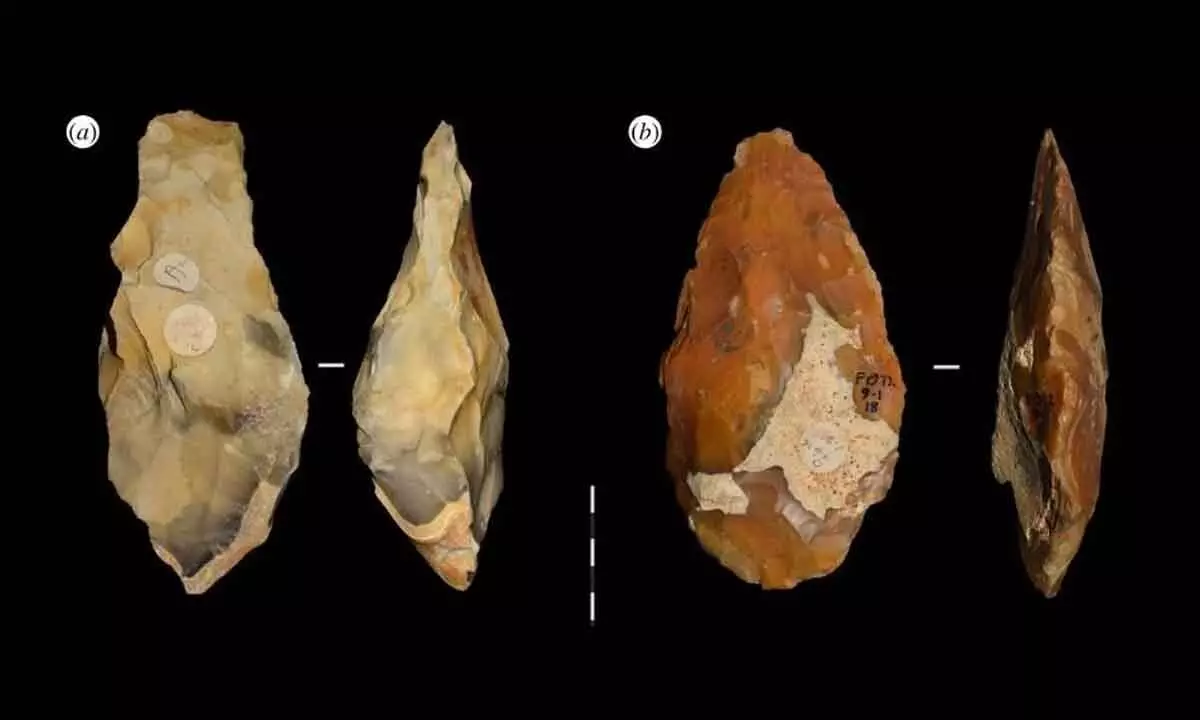Live
- Tamil Nadu Law And Order Crisis: Opposition Intensifies Attack On DMK Government
- Kerala CM Vijayan Rallies MPs To Press Centre On Pending State Demands
- Ramoji Group Donates ₹30 Crore to Indian School of Business (ISB)
- Celebrating the power of thought
- President Droupadi Murmu Arrives in Hyderabad to Attend Koti Deepotsavam
- Border-Gavaskar Trophy 2024-25: Rohit Sharma to join Indian team midway of Perth Test, set to be available from second Ind vs Aus Test
- Scholarships For Students
- EFLU hosts talk on 75 years of the Indian Constitution
- Mohan Babu: Half a Century of Cinematic Brilliance and Unwavering Legacy
- Chandrababu Vows Strict Measures for Women's Safety and Drug Control
Just In
600,000-Year-Old Britain's Toolmakers Discovered


Fordwich handaxes discovered in the 1920s.
- Some of the earliest tools in Britain were discovered at a little-known archaeological site outside of Canterbury.
- The greater than 330 hand axes and 251 flakes, scrapers, and cores in the collection were most likely made between 560,000 and 620,000 years ago.
Some of the earliest tools in Britain were discovered at a little-known archaeological site outside of Canterbury. The majority of the relics were discovered in the 1920s near the Kent market town of Fordwich, but they weren't correctly dated until recently.
The greater than 330 hand axes and 251 flakes, scrapers, and cores in the collection were most likely made between 560,000 and 620,000 years ago. The tools are frequently attributed to a species of early humans called Homo heidelbergensis because of the way they were produced.
With evidence of their presence dating back around 500,000 years, these people may have been among the first humans to permanently inhabit Britain; however, evidence of a previous occupation by an unidentified human species suggests that there may have been brief forays into the region as far back as just under 1 million years ago.
For context, Neanderthals appeared on the scene some 400,000 years ago, and our species didn't appear on the island until around 40,000 years ago.
Although no human remains were discovered at Fordwich, members of H. heidelbergensis are known to have been skilled hunters. The sheer volume and variety of tools found there indicate that these early humans were very much at home in the area.
The hand axes and scrapers discovered at Fordwic are thought to have been used by H. heidelbergensis to prepare animal hides for use as clothing or a shelter.
Palaeolithic archaeologist Tomos Proffitt from the Max Planck Institute, the variety of stone tools found in both the first discoveries and our more recent, smaller excavations indicate that hominins living in what would eventually become Britain were not merely surviving but also prospering.
Although the site is not the earliest sign of human activity in Britain, it is one of the few that offers a look into daily life at the time.
More than 840,000 years old human footprints and simple tools were also discovered in Norfolk, indicating at least brief visits to Europe's chilly northwest. However, it's likely that permanent habitations didn't begin in Britain until much later, when the climate was more livable.
There is still controversy about whether these prehistoric prints were created by Homo heidelbergensis or another early species known as Homo antecessor that was present in Spain at the time.
In any case, Fordwich's ruins serve as a type of link between the earliest visitors to Britain and the first permanent settlers, yet for 90 years, their significance in the early history of humanity was all but overlooked. Meanwhile, th e current investigation, the site's first significant archaeological project, has uncovered some of Britain's earliest artifact-bearing strata.

© 2024 Hyderabad Media House Limited/The Hans India. All rights reserved. Powered by hocalwire.com






